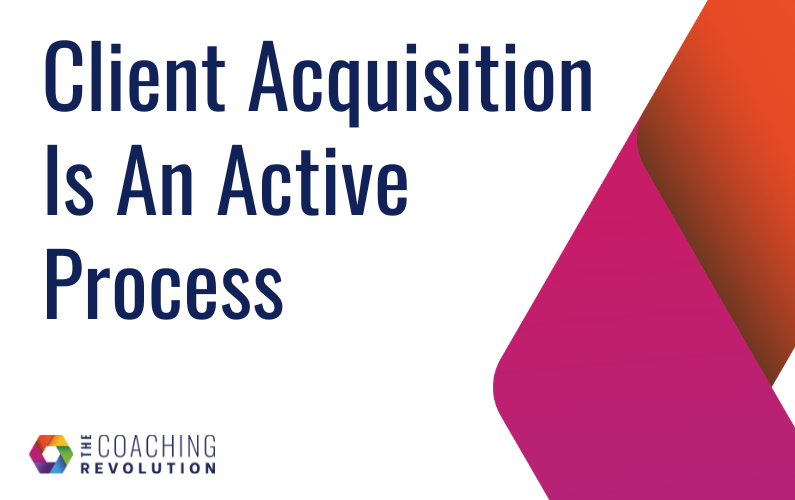Most coaches aren’t inactive when it comes to client acquisition efforts. They’re busy and often frustrated. However, activity isn’t the same as traction and isn’t necessarily a working client acquisition process – unless it follows a structure.
Posting about the wonders of coaching, fiddling with websites no one visits, and attending networking events filled with other coaches might feel like you’re doing something positive towards building your coaching business, but it isn’t. These are vague actions without a strategy. This is passive marketing in disguise.
The courage to accept the obvious
The first step in active client acquisition isn’t tactical, it’s psychological. It starts with accepting that what you’re doing isn’t working, and more importantly, that you don’t know how to fix it.
That takes courage, especially for those who have had a successful career. Client acquisition feels intuitive. We think we should be able to figure it out. The culture that’s grown up around coaching doesn’t help either. We’re encouraged to believe that commercialism isn’t ‘nice’ and shouldn’t be necessary, that if our coaching was good enough, clients would come. But they haven’t yet and despite our hardest efforts, they keep not coming.
What active really means
An active client acquisition process is focused, strategic and repeatable. It begins with acknowledging that you’re missing a skill set and committing to learning it.
This skill set is marketing and marketing includes:
- Choosing a viable and credible audience.
- Developing an Ideal Client Avatar (ICA) that personifies that audience.
- Identifying a real and urgent problem that this audience struggles with.
- Creating a marketing message that speaks to that problem and demonstrates authority and empathy.
- Curating an audience and consistently publishing content that speaks to them.
Most coaches skip this entirely. Then they wonder why their marketing doesn’t work.
Why we resist
Coaches resist this process for reasons that sound noble but are actually flawed.
- We think marketing is sleazy.
- We believe that we wouldn’t need to market if our coaching were good enough.
- We’re told that good conversations will lead to clients.
- We fear that focusing means shutting people out.
- We believe the market is saturated or that no one wants coaching.
There’s also the bogeyman myth. This idea is that terrible coaches with great marketing are stealing clients and giving coaching a bad name. That’s one of the myths that keeps us stuck.
On top of that, most of the advice we get comes from coaches who never had to build a business from scratch. Internal coaches. Associates. People with monetisable credibility. Their advice only works if you have their starting point – if you don’t (and that’s most of us) it won’t.
Narrow to grow
One of the hardest shifts is choosing a niche. Coaches panic at the thought of narrowing their audience. It feels like cutting off opportunities. That fear is understandable, but it’s misplaced.
Common sense tells us that more reach equals more clients. In reality, more reach equals less clarity. You’re not closing doors by focusing. You’re finally giving people a door they can recognise and walk through.
How to know if it’s working
The problem with marketing coaching is that people rarely engage publicly with the content. There’s often shame attached to the kinds of problems coaching can help solve, so likes and comments aren’t reliable indicators.
Here’s what to watch for instead:
- Your audience shifts towards people who look like your ‘ideal client’.
- You get profile views from the right people.
- People message you to say your content resonates.
- You hear your own language reflected back to you.
- People refer others to you, even if they haven’t worked with you.
- Enquiries begin to come in from people you haven’t spoken to.
- People book discovery calls.
- You face fewer – if any – objections around price.
These signals matter because they show your message is landing, even if it isn’t always visible.
Client Acquisition: In summary
Client acquisition isn’t something that happens on its own. It’s something you build slowly, consistently and strategically.
You can keep hoping that clients will come. You can keep posting vague content and pretending it’s marketing. Or you can accept that if you don’t have a process to generate clients, you don’t have a business. You have a hobby.
Once you accept that client acquisition is a skill, everything changes. You stop guessing, you stop chasing, and you start attracting the right people with the right message.
That’s not just activity – that’s business.
Should we talk? Why not book a call to see how The Coaching Revolution could support you…

Recent Comments